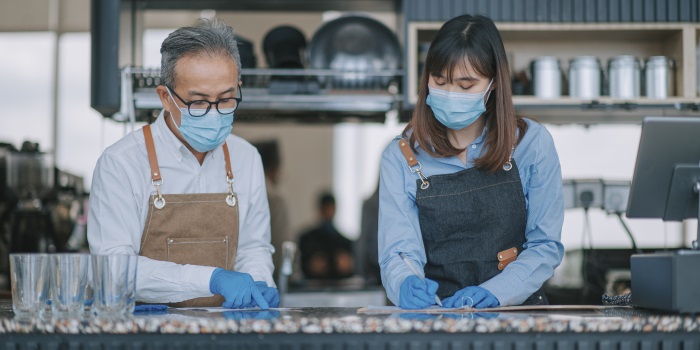Get a handle on disposable gloves: Protect yourself and your guests

 Food handlers must change their single-use gloves after handling raw meat, seafood, or poultry, and before handling ready-to-eat food.
Food handlers must change their single-use gloves after handling raw meat, seafood, or poultry, and before handling ready-to-eat food.According to the National Restaurant Association’s COVID-19 Operating Guidance, operators should train employees on the importance of frequent hand washing, the use of hand sanitizers with at least 60% alcohol content, and teach them to avoid touching their faces, whether gloved or bare-handed.
Wearing gloves front-of-house is discouraged and shouldn't replace frequent hand washing and sanitizing.
However, if employees are required to use gloves, they should be taught how to put gloves on and take them off properly after each service, and wash their hands.
Employees in the back of the house who wear gloves for single-use situations can prevent the spread of germs and cross-contamination by changing them after each task, especially when switching up working with raw and cooked foods.
The ServSafe Manager’s Manual 7th edition indicates single-use gloves (emphasis on single use) should be worn when staff members handle ready-to-eat foods, but they don’t need to be worn when employees handle ready-to-eat ingredients for dishes that will be cooked to their correct internal temperature.
When buying single-use gloves, follow these four essential guidelines:
- Purchase gloves approved for foodservice use only.
- If you buy disposable gloves, they should be single-use for food handling only.
- Supply different types of gloves for different tasks. Long gloves could be used for hand-mixing salads, and colored gloves to help prevent cross-contamination.
- Provide gloves of varying types and sizes. Latex alternatives are good for food handlers and guests who may have latex allergies. Consider providing gloves made from other materials.
When using single-use gloves, follow these guidelines to prevent contamination:
- Wash your hands before putting on gloves when starting a new task. You do not need to rewash your hands each time you change gloves as long as you are performing the same task and your hands have not become contaminated.
- Choose the correct glove size. Gloves that are too big won’t stay on. Those that are too small will tear or rip easily.
- When putting gloves on, hold them by the edge. Avoid touching the gloves as much as possible. Once you have them on, check for rips or tears.
- NEVER blow into gloves.
- NEVER roll gloves to make them easier to put on.
- NEVER wash and reuse gloves.
Here are instances when food handlers must change their single-use gloves:
- As soon as the gloves become dirty or torn.
- Before beginning a different task
- After an interruption, such as taking a phone call
- After handling raw meat, seafood, or poultry, and before handling ready-to-eat food
- After four hours of continuous use
Gloves can give food handlers a false sense of security, especially if they aren’t changed as often as needed. Make sure to reinforce correct glove use with all food handlers.
Get more information about the Association’s ServSafe program